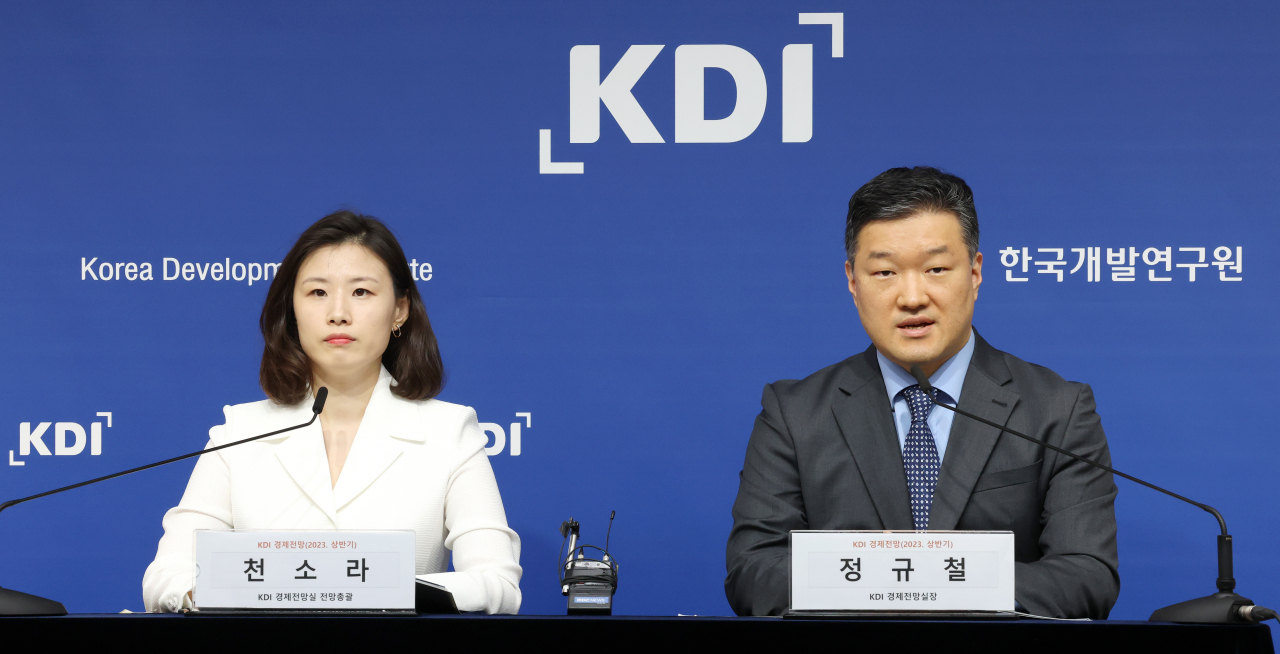KDI slashes Korean economy's growth rate to 1.5% for 2023
By Im Eun-byelPublished : May 11, 2023 - 15:01

The Korea Development Institute, a South Korean state-run think tank, lowered the nation’s growth rate for 2023 to 1.5 percent from 1.8 percent in its previous outlook due to weak exports.
The KDI projected Korea's economy will grow by 0.9 percent in the first half of 2023. It is expected to see 2.1 percent growth in the latter half of the year provided that the Chinese economy picks up and the semiconductor industry recovers from its slump.
In the previous projection given in February, the KDI suggested 1.1 percent and 2.4 percent growth for each half of this year.
“The growth rate for the year was slashed as the Korean economy is slower than the projection made in February and the semiconductor industry is likely to recover later than initially projected,” Jung Kyu-chul, director of the office of macroeconomic analysis and forecasting at the KDI, said Thursday.
Sluggish exports are a major reason behind the cut in the growth rate of Korea, a heavily export-reliant country. The KDI expects the country's exports to experience a 7.6 percent on-year fall, lower than the previous outlook of 5.9 percent.
In a separate report released Wednesday, the institute suggested the chip industry will hit a low point in the second or third quarter of this year.
Another reason behind the slow economy is that China’s reopening has shown limited effects on the South Korean economy. If China's recovery is confined to its domestic service industries and is unable to spread out to further investments at the international level, its effects on Korea could be limited, the institute suggested.
The KDI further warned that the Korean economy could suffer if the situation in Ukraine worsens, leading to a spike in the prices of grain and energy, or if the global economy is unable to recover due to the continued monetary tightening policy of major countries.
The KDI initially suggested in May 2022 that Korea’s economy in 2023 would show 2.3 percent growth. It lowered the growth rate to 1.8 percent in November and maintained the figure in February, though other institutions lowered their projections in response to the slow economy at the time.
The International Monetary Fund slashed Korea’s growth rate from 1.7 percent to 1.5 percent in April. The Asia Development Bank and the Organization for Economic Cooperation and Development suggested 1.5 percent and 1.6 percent growth, respectively. The Bank of Korea suggested 1.6 percent growth in February, but the central bank is expected to cut the figure soon.
"Though the Korean economy is expected to pick up in the second half of 2023, it does not mean that the economy will necessarily be good in the latter half. It will still be slow, yet relatively better than for the first half of 2023," Jung explained.







![[Graphic News] More Koreans say they plan long-distance trips this year](http://res.heraldm.com/phpwas/restmb_idxmake.php?idx=644&simg=/content/image/2024/04/17/20240417050828_0.gif&u=)
![[KH Explains] Hyundai's full hybrid edge to pay off amid slow transition to pure EVs](http://res.heraldm.com/phpwas/restmb_idxmake.php?idx=644&simg=/content/image/2024/04/18/20240418050645_0.jpg&u=20240419100350)








![[KH Explains] Hyundai's full hybrid edge to pay off amid slow transition to pure EVs](http://res.heraldm.com/phpwas/restmb_idxmake.php?idx=652&simg=/content/image/2024/04/18/20240418050645_0.jpg&u=20240419100350)

![[Today’s K-pop] Illit drops debut single remix](http://res.heraldm.com/phpwas/restmb_idxmake.php?idx=642&simg=/content/image/2024/04/19/20240419050612_0.jpg&u=)